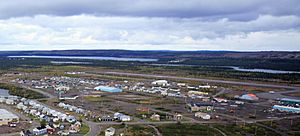Matimekosh facts for kids
Quick facts for kids
Matimekosh
|
||
|---|---|---|
|
Indian reserve
|
||
 |
||
|
||
| Country | ||
| Province | ||
| Region | Côte-Nord | |
| Regional county | None | |
| Settled | 1972 | |
| Formed | 1968 | |
| Area | ||
| • Total | 0.65 km2 (0.25 sq mi) | |
| • Land | 0.69 km2 (0.27 sq mi) | |
| There is an apparent contradiction between two authoritative sources | ||
| Population
(2021)
|
||
| • Total | 661 | |
| • Density | 963/km2 (2,490/sq mi) | |
| • Change (2016–21) | ||
| • Dwellings | 227 | |
| Time zone | UTC-5 (EST) | |
| • Summer (DST) | UTC-4 (EDT) | |
| Postal Code |
G0G 2T0
|
|
| Area code(s) | 418 and 581 | |
| Website | https://matimekush.com/ | |
Matimekosh (also known as Matimekush) is a special area for First Nations people in Quebec, Canada. It is officially called Matimekosh 3. This area is a reserve located on Lake Pearce in the Côte-Nord region.
Matimekosh is part of the Innu Nation of Matimekush-Lac John. It is found right in the middle of the town of Schefferville. The name Matimekosh means "small trout".
You can only reach Matimekosh by flying into Schefferville Airport. You can also take a train from Sept-Îles using Tshiuetin Rail Transportation. The community has a health clinic, a radio station, a library, and a community center. The town of Schefferville helps with water, sewer, and fire services.
Contents
History of Matimekosh
Early Days and Relocation
The Innu people often visited this area to hunt and trap. They did not live here all the time. In the early 1950s, mining started to grow in the region. About 200 Naskapi people moved to Schefferville in 1955. They came from Fort Chimo and built homes near the train station.
In 1956, about twelve Innu families arrived. They came from Maliotenam, near Sept-Îles. They set up a camp near Knob Lake. These families helped guide people doing geological work. They also helped build the railway from Sept-Îles.
Moving to John Lake
In 1957, the town of Schefferville moved the Innu and Naskapi people. They were moved to a place called John Lake. This site was about four miles north of Schefferville. People lived there in difficult conditions. They did not have water, proper sewers, electricity, schools, or medical care.
At first, they lived in very small shacks. By 1962, the government built 30 houses for them. This helped improve their living situation.
Creating the Reserve
In 1967, the Canadian government bought land from Schefferville. This land was a wet area of about 37 acres on Pearce Lake. It was north of the town center. On August 21, 1968, this land officially became a reserve. It was meant for the Innu and Naskapi people.
However, they did not move there right away. It took long talks and negotiations. They finally moved to the reserve in 1972.
Changes in the 1970s and 1980s
In the 1970s, the Naskapi people started talking about their land rights. In 1978, they agreed to give up their rights to the Matimekosh Reserve. This was part of a larger agreement called the Northeastern Québec Agreement. This agreement allowed them to form their own reserve.
In 1983, the Naskapi moved to their new reserve. This new place was called Kawawachikamach. After they left, the Innu people became the only residents of the Matimekosh Reserve.
In 1982, the Iron Ore Company of Canada closed its mines. These mines were near Schefferville. Many people living in the town left. In 1985 and 1995, the Canadian government bought more land. This land was from the former town of Schefferville. It was added to the reserve in 1996 and 1998. This helped bring new life to the reserve. It allowed them to use some of the town's old buildings and services.
Population and People
As of 2022, the Matimekosh band has 1,042 members. About 849 of these people live in the community. The reserve has 194 homes where people live.
Languages Spoken
The main languages spoken in Matimekosh are:
- English: 1.6% of people speak it as their first language.
- French: 9.8% of people speak it as their first language.
- Other languages: 86.2% of people speak other languages as their first language. This often includes Innu-aimun, the language of the Innu people.
Population Changes Over Time
The number of people living in Matimekosh has changed over the years:
- 2021: 661 people
- 2016: 638 people
- 2011: 540 people
- 2006: 528 people
- 2001: 449 people
- 1996: 147 people (or 397 when adjusted for new boundaries)
- 1991: 389 people
Local Economy
The economy in Matimekosh mainly focuses on goods and services. There are several businesses on the reserve. These businesses help the community. They include:
- A convenience store
- A pharmacy
- A gas station
- Services for heavy equipment
- Auto mechanics
- Camping suppliers
- Plumbers
- Outfitters (companies that provide supplies for outdoor activities)
The Corporation de développement économique Matimekush - Lac John helps to grow the economy. This organization works to create more business opportunities.
Education
Matimekosh has one school called École Kanatamat Tshitipenitamunu. This school teaches students from pre-Kindergarten up to Secondary 4 (which is like grade 10). In the 2008-2009 school year, 114 students attended this school.
Getting Around
Matimekosh is a remote community. It is not connected to the main road system of Quebec. You can get there by flying into the Schefferville Airport. You can also take a train. The nearby town of Schefferville is the last stop for the Tshiuetin Rail Transportation train. This train travels from Sept-Îles.



